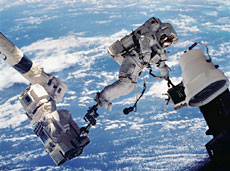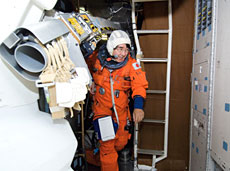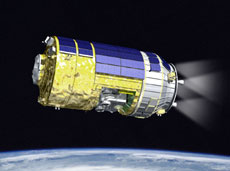

An astronaut working on the robotic arm during a spacewalk (courtesy of NASA)
Q. Some people think it's unnecessary for humans to travel to space because the work can be done by robots. What's your opinion about this?
In space, in my opinion, it is important to incorporate the best of robots and astronauts, co-existing and working together. In particular, the space station is such a large and complicated structure, it is impossible to maintain everything manually so some aspects need to be automated. Having said that, human beings have more sophisticated comprehension and communication skills than robots, so I think in the end, it is necessary to have astronauts, who are able to form and articulate opinions as well as to communicate with specialists on the ground.
In addition, one of the major objectives of the space station is to help expand human activity in space, so I think it is very important to study the impact of the space environment on human bodies.

Astronaut Doi in training (courtesy of NASA)
Kibo is Japan's first permanent space facility. I think it has the same level of significance in the history of Japanese space development as our first rocket or first satellite launch. I feel very honored to be part of such a project.
I've been involved in the development of Kibo for many years, and I think that its experiment payloads and systems are now more user-friendly and reliable overall. Kibo will also be used by astronauts from other countries, such as the United States, Europe, and Russia, and these astronauts, who have received their Kibo training in Japan, think highly of its hardware and software. Kibo is the result of Japan's excellence in technology and engineering. Every detail, right down to the rivets, is made with such meticulous care, that Kibo is often complimented as a module of very fine craftsmanship. I hope that Kibo will perform well in space, and live up to this reputation.
In the meantime, deciding on the future use of Kibo is very important. The first experiment theme for Kibo was chosen about 15 years ago, but since then, science and technology have progressed rapidly, expanding the range of experiments that can be conducted on the ground. In order to make the best use of Kibo as well as make new discoveries, I think Japan should focus on designing new experiments and new tools based on radical new ideas and perspectives. I also think that in the future, researchers should be given an opportunity to conduct space experiments independently, and corporations should be able to invest in research using the payloads on Kibo. Building a system for effective utilization of Kibo will be essential.

HTV - the H-II Transfer Vehicle
Q. The launch of the 1 J/A mission is coming up soon. How are you feeling about it? And, what is your next goal?
I was selected as an astronaut in 1985, and this mission is the realization of my dream. I really want to make the Kibo assembly successful. Kibo will start operating soon, but my primary goal at the moment is to install Kibo on the ISS safely and carry out my other duties successfully.
At the same time, Japan doesn't have its own means to reach its own permanent facility in outer space. JAXA has developed the HTV (H-II Transfer Vehicle), but this is an unmanned transportation vehicle to supply materials, such as food, clothing, and experiment payloads, to the ISS. The HTV is, of course, a great accomplishment, but I hope that Japan will soon have its own spacecraft to carry humans to space. Japanese space development began with an unmanned rocket, and now, in the era of the space station, I think that Japan faces a major challenge in shifting to the next phase. Once Kibo is complete, it will be very important for Japan, as a nation, to consider the direction of its expansion into space. I'd like to continue contributing to this national enterprise as much as I can.
Dr. Takao Doi
Astronaut, Human Space Technology and Astronauts Department, Human Space Systems and Utilization Program Group, JAXA
Born in Tokyo in 1954, Dr. Doi received a B.S. in Aeronautics in 1978, and a Ph.D. in Aerospace Engineering in 1983, both from the University of Tokyo. He studied space propulsion systems as a research student at the Institute of Space and Astronautical Science (ISAS) from 1983 to 1985. Dr. Doi joined the National Space Development Agency of Japan (NASDA, now JAXA) in 1985, when he was selected as a Payload Specialist candidate for NASA's First Material Processing Test (FMPT/ STS-47, also known as Spacelab-J mission).
In 1987-88, Dr. Doi conducted research on microgravity fluid dynamics at the Center for Atmospheric Theory and Analysis at the University of Colorado. In 1990, he was assigned as a backup payload specialist for the FMPT mission and participated in the NASA PS training program. In 1996, he was certified as a Mission Specialist by NASDA and NASA. In 1997, he flew aboard Space Shuttle Columbia on the STS-87 mission. During the 16-day mission, Dr. Doi validated the tools and procedures for the assembly of the International Space Station. He also successfully retrieved a satellite manually - an unscheduled operation - and became the first Japanese astronaut to conduct a spacewalk.
In 2001, Dr. Doi began advanced training to prepare for a long-term flight aboard the ISS. In 2004, he received a Ph.D. in Astronomy from Rice University in Houston, Texas.
The Japanese Experiment Module Kibo will be launched on three space shuttle missions. Dr. Doi has been assigned as a crew member for the first of these flights, to launch the Experiment Logistics Module Pressurized Section (ELM-PS).
Astronaut, Human Space Technology and Astronauts Department, Human Space Systems and Utilization Program Group, JAXA
Born in Tokyo in 1954, Dr. Doi received a B.S. in Aeronautics in 1978, and a Ph.D. in Aerospace Engineering in 1983, both from the University of Tokyo. He studied space propulsion systems as a research student at the Institute of Space and Astronautical Science (ISAS) from 1983 to 1985. Dr. Doi joined the National Space Development Agency of Japan (NASDA, now JAXA) in 1985, when he was selected as a Payload Specialist candidate for NASA's First Material Processing Test (FMPT/ STS-47, also known as Spacelab-J mission).
In 1987-88, Dr. Doi conducted research on microgravity fluid dynamics at the Center for Atmospheric Theory and Analysis at the University of Colorado. In 1990, he was assigned as a backup payload specialist for the FMPT mission and participated in the NASA PS training program. In 1996, he was certified as a Mission Specialist by NASDA and NASA. In 1997, he flew aboard Space Shuttle Columbia on the STS-87 mission. During the 16-day mission, Dr. Doi validated the tools and procedures for the assembly of the International Space Station. He also successfully retrieved a satellite manually - an unscheduled operation - and became the first Japanese astronaut to conduct a spacewalk.
In 2001, Dr. Doi began advanced training to prepare for a long-term flight aboard the ISS. In 2004, he received a Ph.D. in Astronomy from Rice University in Houston, Texas.
The Japanese Experiment Module Kibo will be launched on three space shuttle missions. Dr. Doi has been assigned as a crew member for the first of these flights, to launch the Experiment Logistics Module Pressurized Section (ELM-PS).